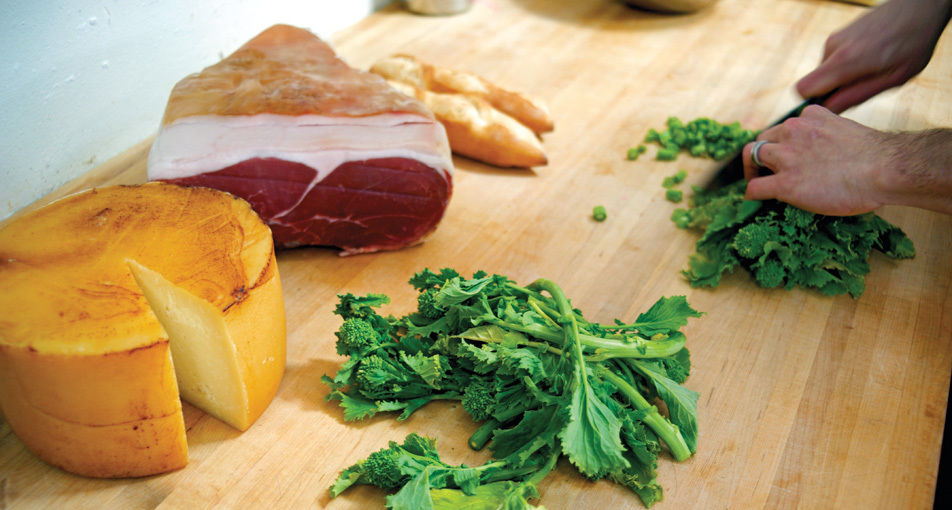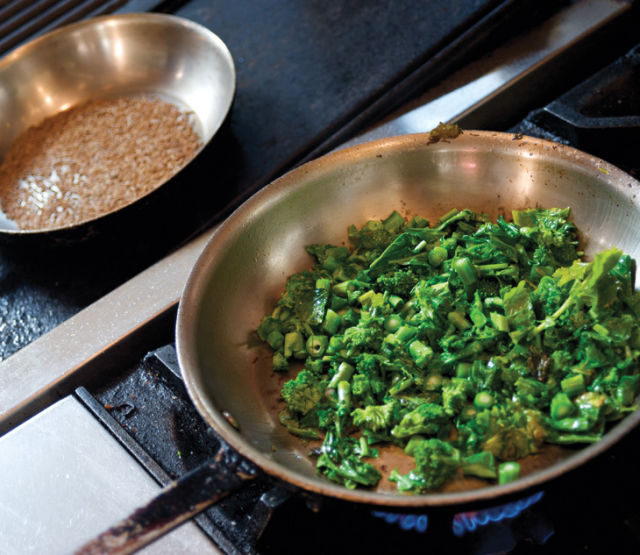Iberian Grinder

Image: David Lanthan Reamer
LONG–SIMMERED SOUPS, slow roasts, braised ribs—winter cooking certainly has its charms. Such classic dishes warm the kitchen, the home, and many a sun–starved Northwest soul. But once the vernal equinox draws its seasonal line in the sand and the itch for something lighter—and greener—sets in, these decadent meals add a bit too much ballast in the belly.
Luckily, we Portlanders can thank our temperate climate for allowing us year–round access to a canon of leafier alternatives. Spring is high season for flavor–packed veggies like mustards, kale, chard, and turnip greens, all of which prefer cooler temperatures to the heat of summer. And while they’re often relegated to the salad bowl, these greens add a bright kick—and a healthy dose of phytochemicals—to any dish.

Image: David Lanthan Reamer
Anthony Cafiero, the chef de cuisine at Tabla Mediterranean Bistro in Northeast Portland, has long been smitten with these shoulder–season greens. “I’m not one of those chefs who just thinks about pork belly,” he says, laughing. “I want to showcase vegetables.” At Tabla, Cafiero explores the cuisine of Western Europe, dreaming up creative, modern dishes for a three–course sampling of seasonal ingredients. In the summer, he scours the Portland Farmers Market relentlessly for greens like chickweed, purslane, and ice lettuce. In the colder months of winter and spring, he turns to local farms for veggies with a bit more bite: “I go for greens with a lot of character—dandelion, rapini, mustards—that really stand up to winter flavors,” he says.
Cafiero puts the spotlight on his favorite greens in this Spanish sandwich, or bocadillo. Like American sandwiches, he explains, bocadillos can be “everything and nothing—they’re utilitarian.” Just don’t expect stateside standby ingredients like Hellmann’s mayonnaise and iceberg lettuce. Instead, the Spaniards stuff their bocadillos with delights like pickled anchovies, fried squid, sliced eggs, cured meats, rubbed tomatoes, and most importantly, greens of every stripe.
In this version, Cafiero pairs a slightly bitter rapini (also known as broccoli raab) with a firm smoked sheep’s milk cheese and a savory dry–cured Spanish ham. Riffing on the traditional salsa of the Canary Islands, he transforms the mustardy rapini into a silky mojo verde, usually made with cilantro. (As a bonus, any leftover mojo verde can be thoroughly enjoyed atop fish, or thinned with oil and used to dress potatoes). One nibble of such refreshing, exotic flavors, and you’ll be convinced it’s time to shelve the slow cooker.

Image: David Lanthan Reamer
BOCADILLO WITH RAPINI MOJO VERDE
- 1 small baguette
- 1 bunch rapini, stems trimmed away and washed
- 8 thin slices Spanish Serrano ham or Italian Prosciutto
- 1 small wedge Idiazábal cheese (or another hard sheep’s milk cheese, such as Pecorino)
- 1 tsp ground cumin
- 1 clove garlic, crushed and minced
- 2 tsp sherry vinegar
- 1/2 cup extra virgin olive oil
- Salt to taste
Mojo Verde
(1) Roughly chop the Rapini into small pieces. (2) Heat a medium pan over medium-high heat and add rapini, tossing lightly for 3 to 4 minutes, until the stems become soft. (3) Transfer to a food processor and pulse until rapini resembles a pesto base. (4) Add fresh garlic, cumin, and sherry vinegar and puree. (5) Add olive oil slowly, creating an emulsion. (6) Season with salt to taste and set aside in a small bowl.
Bocadillo
(1) Slice the baguette lengthwise and spread the mojo verde on both sides. (2) Layer each side with Serrano ham. (3) Slice Idiazábal cheese onto one side of the sandwich (using a vegetable peeler or wide ribbon grater), creating a thin layer. (4) Assemble the bocadillo and cut crosswise.




